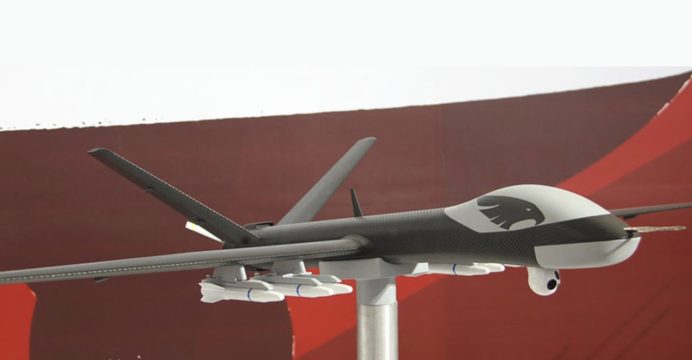AVIC TO LAUNCH NEW WING LOONG UAV VARIANT IN 2018
The Aviation Industry Corporation of China (AVIC) will launch a new variant of the Wing Loong-series of medium-altitude long-endurance (MALE) unmanned aerial vehicles (UAV) – the Wing Loong ID (or I-D).
Reported by China’s state-owned news agency
on January 25, AVIC subsidiary the Chengdu Aircraft Design & Research Institute (CADI) will conduct the maiden flight of the Wing Loong ID in 2018. The Wing Loong ID will also enter the market by the end of this year.
The Wing Loong ID will be a direct improvement of the Wing Loong I, which first flew in 2007 and has been exported to foreign customers (especially in the Middle East) since at least 2012.
Li Yidong, CADI’s vice chief designer and the chief designer of the Wing Loong series, reportedly said that the Wing Loong ID will be more capable and more affordable than the Wing Loong I. Changes include an increase in flight ceiling, endurance, internal and external payload along with a higher-output engine.
“The Wing Loong ID is the first generation of improved reconnaissance-strike UAS [unmanned aerial system] in China. With other members of the family, it will help enhance the influence of Wing Loong brand in the global military trade market,” said Li Yidong.
Analyst Henri Kenhmann of the
website reports, quoting CADI director JI Xiao Guang, that CADI expects the Wing Loong-series to secure €1.9 billion in sales to domestic and overseas clients over the next five years. It also seems that the Wing Loong ID’s airframe will be built from only composites.
Notes & Comments:
Originally designated Pterodactyl, the Wing Loong MALE UAV-series competes with fellow-AVIC subsidiary China Aerospace Science and Technology Corporation (CASC)’s CH-4-series in the market of strike-capable ISR (intelligence, surveillance and reconnaissance) drones. Between the two, AVIC has been able to secure a leading position in the Middle East and Central Asian markets. Saudi Arabia is believed to be among the Wing Loong’s users, though it is unclear if Riyadh is behind the marquee purchase of Wing Long II, the first major iterative variant of the Wing Loong and CADI’s largest overseas drone sales to-date.
AVIC may be intending to have the Wing Loong ID directly supplant the Wing Loong I and to complement the Wing Loong II. In effect, the Wing Loong ID would be the lower-cost alternative to the Wing Loong II. With the Wing Loong ID, AVIC would have a means through which it can aggressively expand its market-share in the market, especially in cost-sensitive markets such as Latin America and Sub Saharan Africa.
It will be interesting to see how other drone makers will respond. The bulk of the U.S. industry’s efforts are focused on supplying aircraft to the U.S. and NATO markets, but Textron is
in those as well as other markets with the Nightwarden UAV. Likewise, Turkish Aerospace Industries (TAI) has been marketing its Anka UAV to Middle East and Southeast Asian markets, the latter – especially where Beijing does not notably strong defence relations or customers – could be viable for TAI. Latin America could be a key market which could see genuine competition (which had been lacking in the Middle East and Central Asia due to the U.S.’ refusal to supply armed drones, freeing the space for China). The likes of Brazil, Chile, Colombia, Peru and Argentina, while relatively cost-sensitive, are still capable of executing large purchases of big-ticket items. This market could be key for AVIC and TAI, especially following the exit of Harpia Sistemas – a joint-venture between Israel’s Elbit and Brazil’s Embraer and Avibras– as an active factor to design, develop and manufacture UAVs in Brazil for this region.


